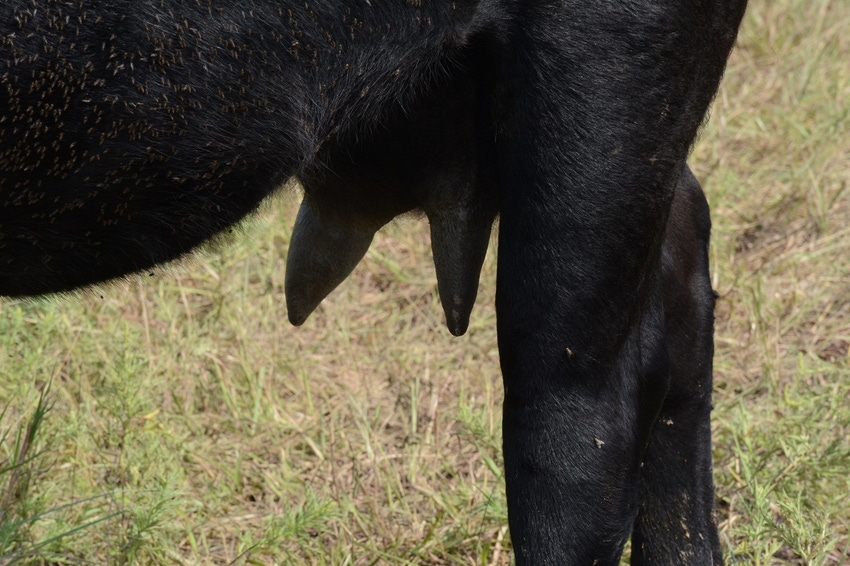Nebraska research on range cows found calf performance unaffected by udder quality, unless it prevented nursing.

In a five-year study of roughly 2,000 crossbred cows at the Gudmundsen Sandhills Laboratory at Whitman, Nebraska, researchers found little reason to cull most cows for poor udder confirmation.
Each cow was assigned an udder score each year at calving, from 1 to 5, using an udder and teat combination score. An udder score of 1 or 2 indicated pendulous udders and large teats, whereas scores 3 to 5 consisted of tight udders and small, symmetrical teats. An udder score of 3 would be considered the commercial cow average score, they said.
The cows were grouped by udder scores and classified as either:
Low udder score (LUS, udder score 1 or 2; 223 cows), or
High udder score (HUS, udder score 3 or 4; 1,742 cows).
They did not record an udder score of 5 in the study.
The researchers reported that cow body weight at pre-breeding and weaning was greater in LUS cows compared with HUS counterparts. They speculated that body weight differences might be attributed to variability of cow size and age over the five-year period within each udder group because, on average, LUS cows were older at 5 years old than HUS cows at 4 years old. This may have resulted in LUS cows being more mature and having greater weights.
They also noted pregnancy rates were not statistically different between LUS cows at 83.2% and HUS cows at 86.9%.
It has generally been accepted that if teat and udder conformation limits the ability of a calf to suckle, then udder conformation may limit a calf’s genetic potential for growth. However, in this study, calf weight at birth, weaning and adjusted to 205-days were similar between udder score groups.
Similarly, some researchers have reported no differences in calf weaning weight due to teat conformation of the dam, which may indicate a lack of relationship between udder conformation and calf growth. However, some research has reported dams with poor udder conformation weaned lighter calves compared with well-attached udder counterparts.
Although most research about udder conformation on calf performance ends at weaning and not the entire production system, in this study cow udder score did not influence feedlot entry and final body weight or performance. The researchers measured feed intake, average daily gain, and gain-to-feed ratio of steer progeny. However, steers suckling HUS dams had greater carcass weights (858 versus 827 pounds) and backfat thickness (0.57 versus 0.50 inches) compared with LUS counterparts.
The researchers in Nebraska suggested the conflicting results in carcass weight and finishing body weight may have been due to increased variability in final body from factors such as mud and gut fill. In addition, HUS steers had numerically greater final body weight than LUS steers (1,385 versus 1,360 pounds) which may have influenced the increased carcass weight.
Overall, this study suggests that cows with less desirable udder structure may not have a negative impact on calf pre-weaning growth and performance. However, backfat thickness and HCW in the finishing phase were lower in steers from cows with a lower udder score. The researchers in their published report concluded that culling cows for poor udder conformation may not be warranted, if calf suckling at birth is not an issue.
About the Author(s)
You May Also Like
.png?width=300&auto=webp&quality=80&disable=upscale)


